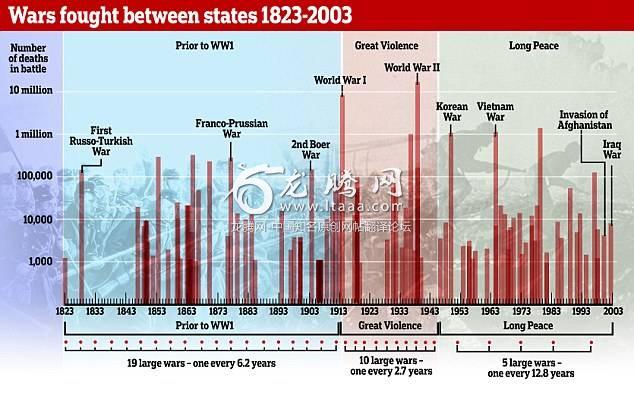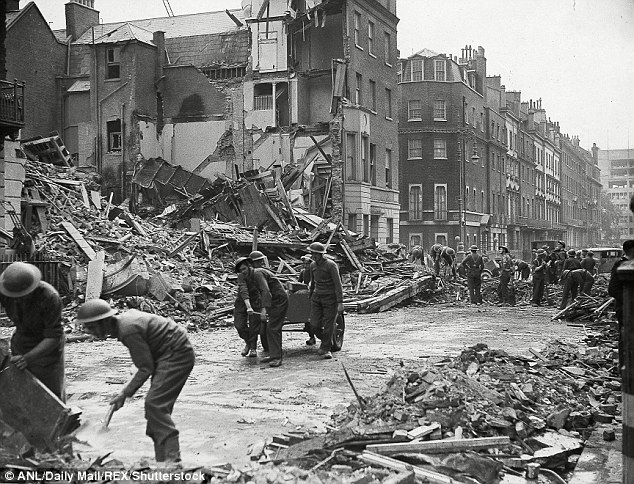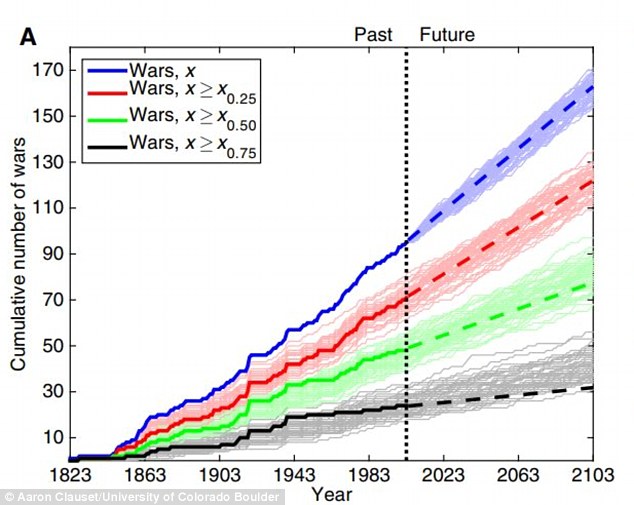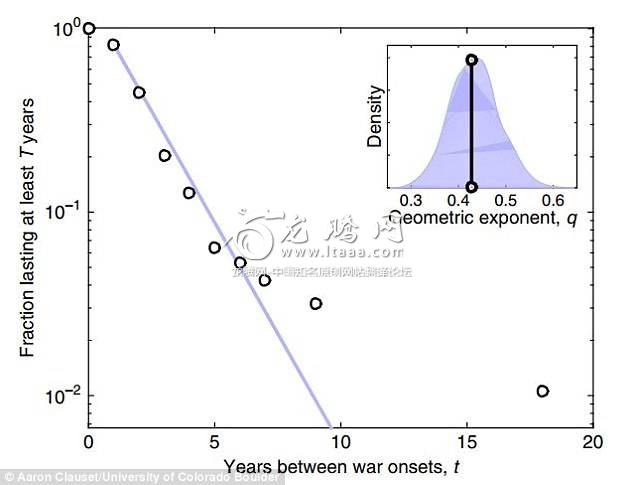凛冬远去了吗?数学家认为二战结束以来的“长期和平”只是历史上的昙花一现而已 [英国媒体]
二战以来人类过着相对和平的日子。与过去两个世纪相比,这段没有大规模战争和人员丧生的时期堪称“长期和平”。但是这种和平状态是一种长期的趋势呢?还是说其实我们已处于大战爆发的边缘了?
Are we overdue a massive war? 'Long peace' since the end of WWII could simply be a blip in history, mathematician claims
凛冬远去了吗?数学家认为二战结束以来的“长期和平”只是历史上的昙花一现而已。
● Since 1945 there have been far fewer wars between countries in the world
● Colorado statistician looked at whether this 'long peace' is just a statistical blip
● He analysed the frequency and size of major conflicts between 1823 and 2003
● He found conflicts as large as the WII would occur on average every 205 years
● This peace would have to endure for a further 100-150 years before humans will have changed our ways for good
●自1945年以来国家之间的战争极少。
●科罗拉多大学的统计学家认为这段“长期的和平”只是一种统计学上的暂时现象
●他分析了从1823-2003年之间主要冲突的频率和规模
●发现类似二战规模的冲突平均每205年发生一次(注:记者不严谨,应该是类似二战的大战会在205年后发生)
●凛冬来临以前,和平还能持续100-150年
【日期】2018年2月23日
Humanity has lived in relative peace since the end of World War II.
二战以来人类过着相对和平的日子。
This period, dubbed the 'long peace', has seen fewer large-scale wars and battlefield deaths compared with the past two centuries.
与过去两个世纪相比,这段没有大规模战争和人员丧生的时期堪称“长期和平”。
But is this a long-term trend or could we be on the brink of a massive war?
但是这种和平状态是一种长期的趋势呢?还是说其实我们已处于大战爆发的边缘了?
According to a new study, conflicts as large as the WII occur on average every 205 years - so it will be another 100 years before we know for sure whether the 'long peace' is here to stay.
根据最新研究,像二战这样的大规模冲突平均每205年爆发一次——这意味着我们要再过100来年才能知晓“长期和平”是否走到尽头。
Since records began on inter-state war data in 1823, there have been 95 total wars. Thirty four of them are considered large. Between 1914 and 1945 - a period caleld the 'Great Violence' - a war broke out every 2.7 years
从1823年以来,总共发生了95场战争。其中34场堪称大战。1914-1945年—一段被称作“大暴力”的时期——每2.7年爆发一次战争
The long peace began after WWII and has held for more than 70 years.
二战以后的长期和平已经持续了70多年。
Political scientists argue that various 20th century developments reduced the risk of global conflicts during this period.
政治学家认为20世纪的多样化发展降低了世界大战发生的风险。
These include the spread of democracy, increased economic interdependence, and the threat of nuclear war, according to a report in Science.
这些多样化发展包括民主的传播,经济相互依赖性的增强,以及核战争威胁。
To find out if the long peace is a significant and long-term change, Dr Aaron Clauset from the University of Colorado at Boulder looked at the frequency and size of conflicts between 1823 and 2003.
为了搞清楚这种长期和平是否是一种显着的而且长期的改变,科罗拉多大学的Aaron Clauset博士研究了1823-2003年之间冲突爆发的频率和规模。
He told MailOnline: 'The goal of the study was to assess whether or not the pattern of relatively few large wars since the end of World War II can plausibly be interpreted as a trend, and thus likely to hold in the future.'
他告诉邮报在线:研究的目的在于搞清楚二战结束以来的无大战状态是否真的是一种趋势,而且这种趋势是否能够在未来还能持续下去。
It was in 1823 when records on inter-state conflicts were first kept as part of the 'Correlates of War Project'.
作为“战争影响因素项目”的一部分,该研究将1823年作为第一次记录国家间冲突的开始。
The blitz during WWII cost many people their life and occurred during the 'great violence' between 1914 and 1945. This was the most deadly time period in human history
发生于1914-1945年期间的二战导致了大量死亡。这是人类史上最血腥的一段时间。
All the wars were broken down into four different categories based on how many people died and how costly it was. This graph shows the total amount of wars over time. Large wars are in red. The dashed lines represent the end of WWII and the end of the Cold War
基于战争死亡人数以及战争代价,所有的战争被分为四类。该图展示了1823-2003年所有的战争数目。大规模战争以红色表示。虚线表示二战结束和冷战的结束。
in the study, Dr Clauset looked at how common wars were and how many people died.
Clauset博士观察了战争发生的频率和死亡人数。
Over the 181 year period, there were 95 recorded wars which equaled one every 1.91 years on average, according to the New Scientist.
根据《新科学家》期刊,在181年中,共发生95场战争,相当于平均1.91年就会爆发一场战争。
Dr Clauset divided the period up into three sections.
Clauset博士把这段时间分为三段。
In the first period, from 1823 to 1914, there was a steady stream of large wars, including the Crimean War and the Boer War.
第一阶段为1823-1914年,这段期间战争的发生频率趋于平缓,包括克里米亚战争和布尔战争。
During this time, 19 large battles broke out at an average of one every 6.2 years.
这段时间,每6.2年发生19场大型战争。
When 1914 came round, this all changed with the dawn of the 'great violence'.
到1914年后,随着“大暴力”(great vilolence注:即一战到二战这段时间)的到来一切发生了变化。
Between the start of The Great War and the end of WWII the world saw 10 large wars at an average of every 2.7 years.
从一战开始到二战结束,平均2.7年就会发生10场大型战争。
This resulted in the most violent and widespread loss of human life in recorded history.
这导致了史上最暴力和最广泛的死亡。
ARE WE HEADING FOR WORLD WAR 3?
我们会迎来第三次世界大战吗?
Since 1823 to 2003, a 181-year period, there have been 95 recorded wars between different countries: one every 1.91 years on average.
从1823-2003,这181年中发生了95场国家间的战争:平均每1.91年就发生一场战争。
Larger wars, those with the most deaths, were far less common.
较大规模的战争,即死亡人数极大的战争,其实发生的并不多。
World War One lasted between 1914 and 1918 and World War Two spanned from 1939 to 1945.
一战发生于1914-1918年,二战发生于1939-1945年。
The Great War (WWI) cost an estimated 21 million people their lives.
一战导致了大约2100万人丧生。
The Second World War lasted longer than the first and killed ab estimates 85 million people - more than the entire population of Germany in 2017.
二战持续时间更长,而且约8500万人丧生——超过了2017年的德国总人口。
The time between, and including, these wars has been dubbed the 'great violence'.
这段时间以及当时的战争后来被称作“大暴力”(great violence)时期。
Before then there was a total of 19 large wars, one every 6.2 years dating back to 1823.
而在此之前,每6.2年才发生19场大型战争(1823年开始)。
After World War Two, the 'long peace' began which has spanned from 1945 through to present day.
二战以后,“长期和平”从1945年持续到今天。
Only five major inter-state wars have taken place since 1945.
从1945年至今只有5场国家间的战争发生。
Major conflicts now average once every 12.8 years.
每12.8年才发生一次大冲突。
According to research, for the statistical pattern to be significantly different there would have to be a 205 year gap before there is another war as large as WWII.
据研究,从统计学上讲要再发生一次类似二次大战规模的战争还需205年。
Which leaves between 100 and 150 years before we will know if this period of peace is a statistical blip or a new conflict-free era.
这意味着还需100年到150年我们才能知道这个“长期和平”时期究竟只是个统计学意义上的昙花一现还是说我们将真正迎来没有战争的新世纪。
Dr Clauset predicted how long the period of peace would have to last to make sure it is not just a statistical blip. The black dashed line represents the time where the data set finished at 2003 and a linear extrapolation of likely amount of wars in the future
Clauset博士预测了“和平时期”将持续多久。黑色虚线代表统计数据结束于2003年,后面的虚线为预测的未来可能发生战争的数量。
The 'Great Violence' spanned nearly 40 years and followed a time of consistent if not extreme wars. The Great War changed that and 10 large wars broke out at an average of every 2.7 years after 1914
“大暴力”时期跨越近40年,此后一段时间又持续发生了一些并不极端的战争。“大暴力”期间(1914-1945)平均每2.7年发生10场大规模战争。
With the end of the Second World War, a relative calm settled on the world.
二次大战后,世界迎来相对平稳时期。
'Since 1945, there have been relatively few large interstate wars. This pattern, sometimes called the long peace, is highly controversial,' said Dr Clauset.
“从1945年开始,很少再发生国家间的战争。这就是所谓的“长期和平”时期,这种说法是富有争议的” Clauset博士说。
At an average of 12.8 years apart, this is, by comparison to the 'great violence', a tranquil time.
比起“大暴力”时期,“长期和平”时期平均12.8年才发生战争,这是安宁时期。
Dubbed by some experts as the 'long peace', the research focused on how long we can reasonably expect this to last.
学者们最关注的是这种“长期和平”究竟能持续多久。
The worldwide aggression of countries between 1914 and 1945 is, at least statistically, balanced out by the 'long peace' that has endured since.
至少从统计学上来看,1914-1945年被卷入世界大战的国家在“长期和平”时期都维持了平衡状态。
Following the Second World War, the 'long peace' began which points towards there only being five large wars (one every 12.8 years) between 1945 and 2003
二战以后,“长期和平”时期(1945-2003)只发生了五场大规模战争(平均每12.8年1次)。
The analysis showed here that as the amount of deaths in a war increased, the amount of wars with that amount of deaths diminished. The more deadly wars were very rare, with very few reaching the highest levels of death
该图展示了:随着一场战争中死亡人数的上升,相应死亡人数的战争数量就会下降。死亡人数越多的战争数目越少,当死亡人数达到最高战争的数目就极少了。
The analysis of all the wars since 1823 shows that the longer the period of time between wars the shorter the wars tended to be
通过分析1823年后的战争表明,战争之间的间隔时间越长战争持续的越短
Which means the rate of wars over the last 100 years is roughly the same as it was during the 19th century.
这说明过去100年的战争率大约和19世纪的差不多。
Clauset estimates from the data that conflicts as large as the second world war would occur on average every 205 years.
Clauset博士基于这些数据估计出类似二次大战规模的战争会每205年发生一次。
Dr Clauset told MailOnline: 'The risk of a large war in the future may thus be higher than currently believed, and it's crucial that we continue to promote peace and mitigate conflict in the future.'
Clauset博士告诉邮报在线:未来发生大规模战争的风险可能高于我们现在所相信的,所以我们未来要坚持促进和平以及缓和冲突。
The conclusion that we are living in a time of peace is only true for wars between countries, not civil disputes or warring with a rogue faction not considered a 'state'.
我们生活于和平时代这种结论只限于国与国之间没有战争,而不是指内战或者派别斗争这种非国家层面的战争。
Dr Clauset points out that the research data set only goes up to 2003 and therefore several wars of recent memory are not included in the research.
Clauset博士指出研究数据截止于2003年,因此研究并不包括之后的战争。
版权声明
我们致力于传递世界各地老百姓最真实、最直接、最详尽的对中国的看法
【版权与免责声明】如发现内容存在版权问题,烦请提供相关信息发邮件,
我们将及时沟通与处理。本站内容除非来源注明五毛网,否则均为网友转载,涉及言论、版权与本站无关。
本文仅代表作者观点,不代表本站立场。
本文来自网络,如有侵权及时联系本网站。
上一篇: 中国军事力量的“全球化” [英国媒体]
图文文章RECOMMEND
热门文章HOT NEWS
-
1
最近,新冠肺炎疫情在日本有扩大的趋势,有专家呼吁日本应当举国行动起来,共...
- 2
- 3
- 4
- 5
- 6
- 7
- 8
- 9
- 10
推荐文章HOT NEWS
-
1
最近,新冠肺炎疫情在日本有扩大的趋势,有专家呼吁日本应当举国行动起来,共...
- 2
- 3
- 4
- 5
- 6
- 7
- 8
- 9
- 10


















